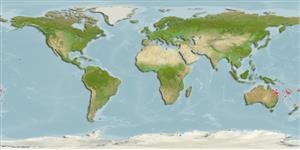Actinopterygii (ray-finned fishes) >
Scorpaeniformes (Scorpionfishes and flatheads) >
Platycephalidae (Flatheads)
Etymology: Platycephalus: Greek, platys = flat + Greek, kephale = head (Ref. 45335). More on author: Cuvier.
Environment / Climate / Range
Ecology
Marine; brackish; demersal; depth range 0 - 30 m (Ref. 6390). Subtropical, preferred ?; 17°S - 38°S
Western Pacific: endemic to Australia. Present along the east coast between approximately Cairns, Queensland (Ref.27242) and Gippsland lakes in eastern Victoria.
Length at first maturity / Size / Weight / Age
Maturity: Lm 47.0 range ? - ? cm
Max length : 120 cm TL male/unsexed; (Ref. 27112); max. published weight: 15.0 kg (Ref. 27248)
Short description
Morphology | Morphometrics
Generally inhabit shallow bays and inlets and can be found in estuaries as far as tidal limits (Ref. 27246); they often invade freshwater. They occur over mud, silt gravel, sand and seagrass (mainly Zostera species) beds from intertidal areas to depths of 10 m in Queensland and to 30 m in southern New South Wales. Eggs and larvae are dispersed along the coast by tidal and current movements (Ref. 27112). Small juveniles less than 12 cm TL first appear in coastal bays 1-2 months after spawning. They mainly inhabit shallow mangrove and mud flats and seagrass beds (Ref. 27246, 27245). They are usually solitary but may form loose aggregations (Ref. 2165, 27247). Feed on small fish, crabs, prawns, small crustaceans. octopus, squid and polychaete worms. They have spines on the outer edges of their head which can inflict nasty cuts during handling (pers. comm., Bernard Moss, 2001).
There is conflicting information (Ref. 27246, 27245, 27247) on whether dusky flahead are protandrous sex reversers or not.
Paxton, J.R., D.F. Hoese, G.R. Allen and J.E. Hanley, 1989. Pisces. Petromyzontidae to Carangidae. Zoological Catalogue of Australia, Vol. 7. Australian Government Publishing Service, Canberra, 665 p. (Ref. 7300)
IUCN Red List Status (Ref. 115185)
CITES (Ref. 94142)
Not Evaluated
Threat to humans
Harmless
Human uses
Fisheries: commercial; gamefish: yes
More information
ReferencesAquacultureAquaculture profileStrainsGeneticsAllele frequenciesHeritabilityDiseasesProcessingMass conversion
Tools
Special reports
Download XML
Internet sources
Estimates of some properties based on models
Phylogenetic diversity index (Ref.
82805): PD
50 = 0.5000 [Uniqueness, from 0.5 = low to 2.0 = high].
Trophic Level (Ref.
69278): 4.1 ±0.52 se; Based on food items.
Resilience (Ref.
69278): Medium, minimum population doubling time 1.4 - 4.4 years (K=0.22; tm=2).
Vulnerability (Ref.
59153): Moderate to high vulnerability (50 of 100) .
